Foros > Sugerencias y Trucos del Juego
Un conjunto simple de fórmulas para Magic Cube
de Novel Games
2008-01-10 15:50:51
#1

(Traducido por Microsoft) Hay muchas maneras de resolver el Cubo de Rubik, pero todas implican el uso de fórmulas para mover los bloques. Algunas soluciones requieren el uso de más de 50 fórmulas, lo cual es bastante difícil de aprender. El siguiente es un conjunto de 3 fórmulas inventadas por el difunto Sr. Ngai Shing Lee, y este conjunto de fórmulas es fácil de aprender y recordar. Tenga en cuenta que se necesitan muchos movimientos y no se puede resolver el rompecabezas muy rápidamente, pero finalmente usted será capaz de resolverlo.
El concepto básico es resolver las esquinas primero y luego los bordes. Esto se basa en una simple observación de que mover las filas centrales por sí solo no interrumpirá las esquinas.
El procedimiento básico es el siguiente:
Ahora comienza con la fórmula A, que intercambia las posiciones de 3 bloques de esquina:
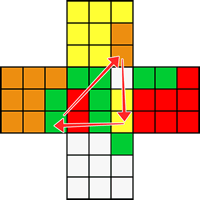
(Para una demostración fácil, el resultado mostrado anteriormente está empezando con un cubo resuelto)
La Fórmula A es la siguiente:
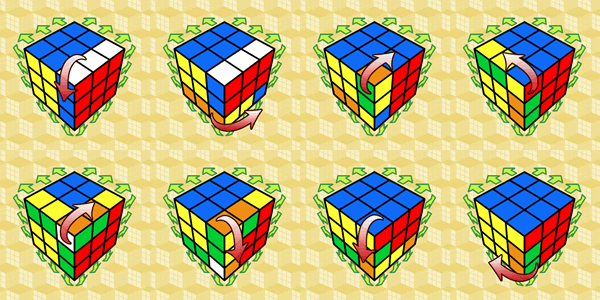
Tenga en cuenta que los primeros 3 pasos implican la eliminación de la esquina inferior derecha de la cara superior, y los pasos restantes son para volver a colocarlo. También puede aplicar una variación de esta fórmula que elimina y coloca de nuevo la esquina inferior izquierda de la cara superior para lograr un efecto similar para los bloques superior izquierdo, inferior izquierdo e inferior derecho en la cara inferior.
Una vez que haya terminado de mover los bloques de esquina de la cara inferior a sus posiciones correctas (pero no necesariamente en las orientaciones correctas), puede aplicar la fórmula B para girar los bloques en sentido contrario a las agujas del reloj:
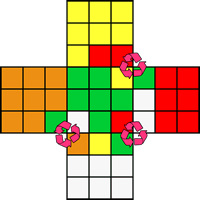
La Fórmula B es la siguiente:
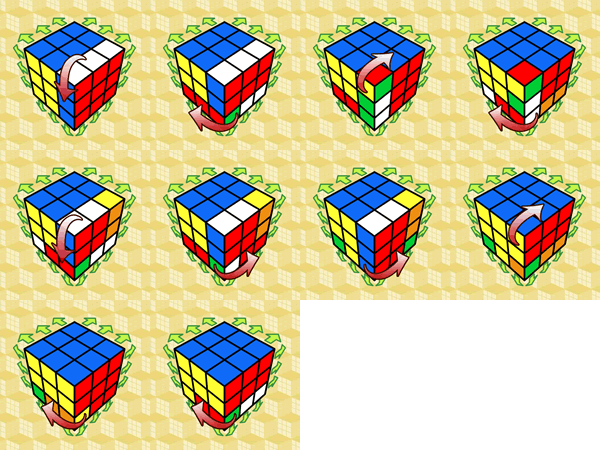
Tenga en cuenta que los primeros 3 pasos implican la eliminación de la esquina inferior derecha de la cara superior, y los pasos restantes son para volver a colocarlo. Si aplica una variación de esta fórmula, los bloques superior izquierdo, inferior izquierdo e inferior derecho en la cara inferior se rotarán en el sentido de las agujas del reloj.
Después de haber terminado todas las 8 esquinas, debe tratar con los bordes utilizando la fórmula C, que intercambia las posiciones de 3 bloques en el borde en sentido contrario a las agujas del reloj:
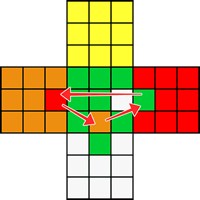
La fórmula C es la siguiente:
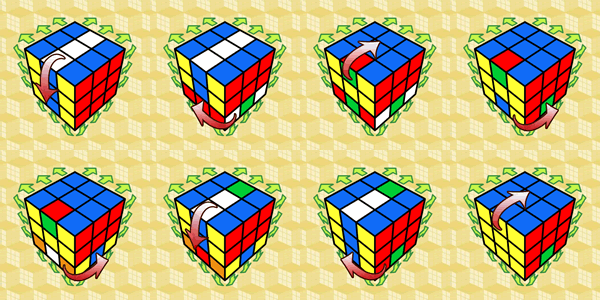
Tenga en cuenta que los primeros 3 pasos implican la eliminación del bloque medio inferior, y los pasos restantes son volver a colocarlo. También puede aplicar una variación de esta fórmula para intercambiar las posiciones de los bloques en el sentido de las agujas del reloj intercambiando las rotaciones izquierda y derecha como se muestra arriba.
Al usar la fórmula C, a veces se enfrentará a una situación de que los bloques incorrectos no están en la misma cara, y en este caso tendrá que hacer movimientos adicionales para mover los bloques incorrectos a la misma cara antes de aplicar la fórmula C.
El concepto básico es resolver las esquinas primero y luego los bordes. Esto se basa en una simple observación de que mover las filas centrales por sí solo no interrumpirá las esquinas.
El procedimiento básico es el siguiente:
- Mueva las cuatro esquinas de una cara a sus posiciones correctas y orientaciones correctas (no debe necesitar ninguna fórmula para esto)
- Utilice la fórmula A para mover las cuatro esquinas restantes a sus posiciones correctas, pero no necesariamente en las orientaciones correctas
- Utilice la fórmula B para girar los bloques de esquina restantes a sus orientaciones correctas. Ahora las ocho esquinas deben ser correctas
- Utilice la fórmula C para mover los bordes a sus posiciones correctas
Ahora comienza con la fórmula A, que intercambia las posiciones de 3 bloques de esquina:

(Para una demostración fácil, el resultado mostrado anteriormente está empezando con un cubo resuelto)
La Fórmula A es la siguiente:

Tenga en cuenta que los primeros 3 pasos implican la eliminación de la esquina inferior derecha de la cara superior, y los pasos restantes son para volver a colocarlo. También puede aplicar una variación de esta fórmula que elimina y coloca de nuevo la esquina inferior izquierda de la cara superior para lograr un efecto similar para los bloques superior izquierdo, inferior izquierdo e inferior derecho en la cara inferior.
Una vez que haya terminado de mover los bloques de esquina de la cara inferior a sus posiciones correctas (pero no necesariamente en las orientaciones correctas), puede aplicar la fórmula B para girar los bloques en sentido contrario a las agujas del reloj:

La Fórmula B es la siguiente:

Tenga en cuenta que los primeros 3 pasos implican la eliminación de la esquina inferior derecha de la cara superior, y los pasos restantes son para volver a colocarlo. Si aplica una variación de esta fórmula, los bloques superior izquierdo, inferior izquierdo e inferior derecho en la cara inferior se rotarán en el sentido de las agujas del reloj.
Después de haber terminado todas las 8 esquinas, debe tratar con los bordes utilizando la fórmula C, que intercambia las posiciones de 3 bloques en el borde en sentido contrario a las agujas del reloj:

La fórmula C es la siguiente:

Tenga en cuenta que los primeros 3 pasos implican la eliminación del bloque medio inferior, y los pasos restantes son volver a colocarlo. También puede aplicar una variación de esta fórmula para intercambiar las posiciones de los bloques en el sentido de las agujas del reloj intercambiando las rotaciones izquierda y derecha como se muestra arriba.
Al usar la fórmula C, a veces se enfrentará a una situación de que los bloques incorrectos no están en la misma cara, y en este caso tendrá que hacer movimientos adicionales para mover los bloques incorrectos a la misma cara antes de aplicar la fórmula C.
(Original) A Simple Set of Formulas for Magic Cube
There are many ways to solve Rubik's Cube, but they all involve the use of formulas to move the blocks. Some solutions require the use of more than 50 formulas which is rather difficult to learn. The following is a set of 3 formulas invented by late Mr. Ngai Shing Lee, and this set of formulas is easy to learn and remember. Note that a lot of moves is needed and you cannot solve the puzzle extremely quickly, but eventually you will be able to solve it.
The basic concept is to solve the corners first and then the edges. This is based on a simple observation that moving the middle rows alone will not disrupt the corners.
The basic procedure is as follows:
Now start with formula A, which swaps the positions of 3 corner blocks:

(For easy demonstration, the result shown above is starting with a solved cube)
Formula A goes as follows:

Note that the first 3 steps involve the removal of the lower right corner of the top face, and the remaining steps are to put it back. You can also apply a variation of this formula which removes and puts back the lower left corner of the top face to achieve a similar effect for the top left, bottom left and bottom right blocks on the bottom face.
After you have finished moving the corner blocks of the bottom face to their correct positions (but not necessarily in correct orientations), you can apply formula B to rotate the blocks counterclockwise:

Formula B goes as follows:

Note that the first 3 steps involve the removal of the lower right corner of the top face, and the remaining steps are to put it back. If you apply a variation of this formula, the top left, bottom left and bottom right blocks in the bottom face will be rotated clockwise.
After you have finished all the 8 corners, you should deal with the edges using formula C, which swaps the positions of 3 blocks on the edge in a counterclockwise direction:

Formula C goes as follows:

Note that the first 3 steps involve the removal of the lower middle block, and the remaining steps are to put it back. You can also apply a variation of this formula to swap the positions of the blocks in a clockwise direction by swapping the left and right rotations as shown above.
When using formula C, sometimes you will face a situation that the incorrect blocks are not on the same face, and in this case you will need to make extra moves to move the incorrect blocks to the same face before applying formula C.
There are many ways to solve Rubik's Cube, but they all involve the use of formulas to move the blocks. Some solutions require the use of more than 50 formulas which is rather difficult to learn. The following is a set of 3 formulas invented by late Mr. Ngai Shing Lee, and this set of formulas is easy to learn and remember. Note that a lot of moves is needed and you cannot solve the puzzle extremely quickly, but eventually you will be able to solve it.
The basic concept is to solve the corners first and then the edges. This is based on a simple observation that moving the middle rows alone will not disrupt the corners.
The basic procedure is as follows:
- Move the four corners of one face to their correct positions and correct orientations (you should not need any formulas for this)
- Use formula A to move the remaining four corners to their correct positions but not necessarily in correct orientations
- Use formula B to rotate the remaining corner blocks to their correct orientations. Now all eight corners should be correct
- Use formula C to move the edges to their correct positions
Now start with formula A, which swaps the positions of 3 corner blocks:

(For easy demonstration, the result shown above is starting with a solved cube)
Formula A goes as follows:

Note that the first 3 steps involve the removal of the lower right corner of the top face, and the remaining steps are to put it back. You can also apply a variation of this formula which removes and puts back the lower left corner of the top face to achieve a similar effect for the top left, bottom left and bottom right blocks on the bottom face.
After you have finished moving the corner blocks of the bottom face to their correct positions (but not necessarily in correct orientations), you can apply formula B to rotate the blocks counterclockwise:

Formula B goes as follows:

Note that the first 3 steps involve the removal of the lower right corner of the top face, and the remaining steps are to put it back. If you apply a variation of this formula, the top left, bottom left and bottom right blocks in the bottom face will be rotated clockwise.
After you have finished all the 8 corners, you should deal with the edges using formula C, which swaps the positions of 3 blocks on the edge in a counterclockwise direction:

Formula C goes as follows:

Note that the first 3 steps involve the removal of the lower middle block, and the remaining steps are to put it back. You can also apply a variation of this formula to swap the positions of the blocks in a clockwise direction by swapping the left and right rotations as shown above.
When using formula C, sometimes you will face a situation that the incorrect blocks are not on the same face, and in this case you will need to make extra moves to move the incorrect blocks to the same face before applying formula C.
de Novel Games
2008-01-10 15:50:51
Me gusta
Responder
Enviar una respuesta
Enviando…
La respuesta no ha podido ser publicada. Por favor, inténtelo de nuevo. Cerrado